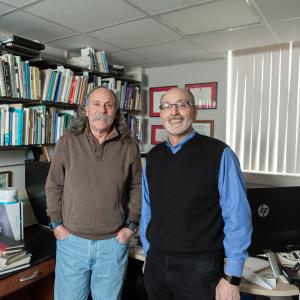For more than 43 years, Professor Jay Pitocchelli, Ph.D., Professor of Biology has studied the song of the Mourning Warbler, something that no one has ever studied before. He started this research during his time as an undergraduate, and later continued with the help from his colleagues. Focusing on the songs across its breeding range, Canada and the northern United States, he tested hypotheses about what was responsible for changes in the birdsongs. Pitocchelli and his colleagues, including Saint Anselm Physics Professor David Guerra, Ph.D., and Computer Science Professor Adam Albina, Ph.D., discovered that cultural evolution caused the Mourning Warbler birds to prefer their species-typical songs but did not cause random changes in the birds’ genes because of the random copying of syllables found in the songs.
“It has been a long journey conducting this research and I am trying to sum it up now in a manuscript for publication for a leading Ornithology journal. I knew back in the 1980s that I had a special opportunity to use my thesis data from the 1980s again sometime in the future. I knew that I would make recordings in the future to answer questions about how birdsongs change over time. This original goal is finally coming to fruition,” said Professor Jay Pitocchelli.

Birdsong is a socially transmitted trait passed on from generation to generation by learning. This trait is typically found in male birds who sing to other males for purposes like territorial ownership, aggressive display, species identification, and individual identification, and females for courtship display, reproductive readiness, fitness, species identification, and individual identification. The syllables of the songs and their occurrences are subject to change over time because of cultural evolution. The physical parameters of the songs may also change in the form of lower frequencies, shorter syllables, and an increase in syllable intervals due to natural selection by ecological characteristics of the breeding habitat (acoustic adaptation).
The nature of this research required an interdisciplinary approach where Professor Jay Pitocchelli, Ph.D., Professor of Biology, collected the song recordings and performed statistical analyses of patterns of song variation over time and space. Additionally, Professors Alexander Bentley, Ph.D., Professor of Anthropology at the University of Tennessee Knoxville, and Mason Youngblood, Ph.D., Minds and Research Group, Max Planck Institute of Geoanthropology, Jena, Germany developed agent-based models of cultural evolution; Professor Guerra acquired the Landsat data, developed landcover indexes, and extracted georeferenced data using ArcGIS Pro software. Lastly, Professor Albina used machine learning algorithms to test hypotheses about acoustic adaptation.
“I needed the expertise of Drs. Adam Albina and David Guerra to work on the second part of this research which was whether there was evidence that ecological characteristics of breeding habitat may have influenced the evolution Mourning Warbler song across the breeding range,” said Professor Jay Pitocchelli.
Professor Guerra collected the latitude and longitude of each birdsong location at each territory with a hand-held GPS. This study further confirmed that these birds were not returning to the same exact location and adapting their songs to changes in the environment, but instead they returned to the same general area and moving to location with the same ground cover.
Professor Albina combined data sets of 1023 observations with 21 variables to address missing values, potential consistency across data sets, creation of regions, and normalization among 947 observations.
“I had a conversation with Dr. J in which I learned about his work and his interest to study the relationship between the bird song characteristics and the environment. I told him that I could provide the satellite data and the analysis capability to study these relationships and our collaboration was born…. I could not have asked for better people to work with than Jay, Adam, and all the research students that have participated in this project,” said Professor Guerra.
Professor Jay Pitocchelli plans to finish writing the manuscript for the publication of this research as well as analyzing data from song playback experiments to determine whether males from 2017-2019 were able to detect differences between modern songs of their period and songs from the 1980s. He is interested in whether songs lose their signal potency over time or whether they still carry the same message that current songs do.
